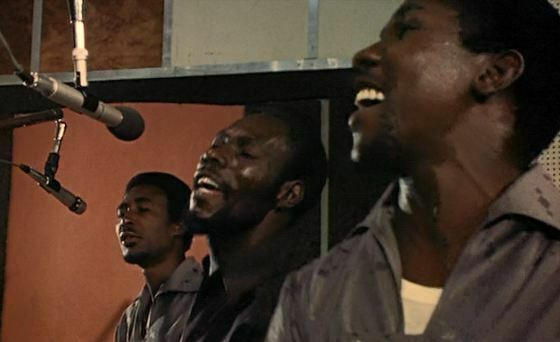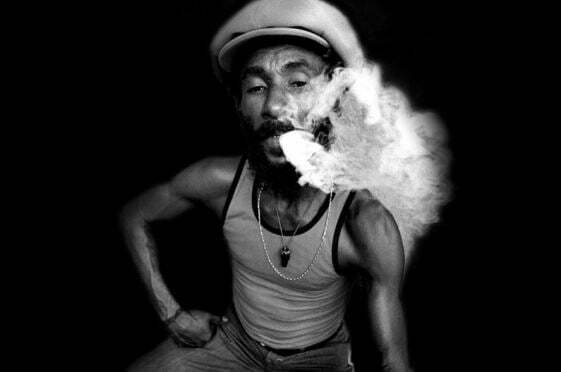
Reggae is island music. It is music that came out of the island of Jamaica, and in its true form could only derive from that place, but its island nature lies deeper. Islands are worlds unto themselves that nevertheless can only be defined by their relation to the worlds that lie beyond. They are proudly independent yet deeply dependent at the same time. They offer a world in microcosm, a destination and an aspiration: As J. Edward Chamberlin says in Island: How Islands Transform the World,
Islands give the world a human shape … When we travel out to islands, we travel in to ourselves. When we look out to islands, we look in to the physical and natural and human history of the world.”
One of the quintessential expressions of Jamaican life, and of reggae as a part of that life, is the 1972 film The Harder They Come, which structures itself around Jamaica as an island. It begins with a bus travelling along a coastal road, taking the country boy Ivan (Jimmy Cliff) to the city (Kingston) in search of fame, and it ends with Ivan, now a notorious killer, returning to the sea, first in a failed attempt to escape the law by ship, then being shot down by policemen on an idyllic sandy shoreline. He has found fame of a kind, but cannot escape the seas that surround and define him.

Reggae music is likewise a reflection of the world beyond yet uniquely a product of its own world. It came out of a rich mix of local folk music and the imported sounds of the outside: New Orleans R’n’B, jazz, soul, calypso, gospel and pop. These evolved into a musical style distinguished by its offbeat rhythm, which emerged as ska and rocksteady in the 1960s, before maturing into the classic reggae sound that flourished so magnificently in the 1970s. It was unsophisticated music on one level, pop tunes stripped back to the basics, but at the same time extraordinarily inventive and knowing. The music served as a commentary on itself through the deconstructing effects of dub, and a commentary on the society which gave rise to it, which in turn was to find worldwide resonance, notably through the music of Bob Marley. It was island music too because of its local messages. Reggae was a way to share information, pass on the news, comment on issues, to express everyone’s thoughts. It circulated ideas, kept in time with the people.

I am working my way through musical genres. Having previously explored excellence in guitar, bass, drums and singing, I am now looking for a style for any such imaginary group to play. As my quartet turned out to be the scarcely compatible Mike Oldfield, George “Fully” Fullwood, Jaki Liebezeit and Sandy Denny, I would strong advise three of them never to attempt reggae at all, but bass player Fullwood, a reggae great who played with Peter Tosh and countless others, does at least give them a little credibility. And if we bring in Lee ‘Scratch’ Perry as producer, perhaps reggae’s arch-alchemist could make something work.
So, having looked previously at blues and country, it is the turn of reggae. Reggae fits in perfectly with my definition of the popular music genre. Such a genre should be specific to a time, a place and a people. Genres rise, evolve and fall, never returning to what they once were. Often they belong only to a generation. Reggae was the product of an island society newly independent of British rule that sought its own sounds as it sought its own identity. It rose with the generation that first experienced independence, then moved on as succeeding generations explored new musical styles while Jamaica built further on its cultural identity. Reggae still exists. It can be played by anyone (mostly quite badly). But reggae in its classic form was the product of a pioneering generation, a religion (Rastafari), not a little herb, and an island.
As before with these lists, I have ten favourites to present. And as before, they are not a top ten, and the ordering is just for fun. Ask me again tomorrow, and they will be ten different numbers entirely. Well, I might keep one or two. Or three.
10. Dandy Livingstone, ‘Suzanne, Beware of the Devil’ (1972)
My earliest memory of reggae is Dandy Livingstone, hunched over an electric piano on Top of the Pops, singing this irresistibly catchy number with its arresting title, neatly worked out across the lyric’s scenario. This and his follow-up hit ‘Big City’ delighted me with their tunefulness, wit and freshness, locking me in to the groove from then onwards.
9. I-Threes, ‘Many Are Called’ (1978)
The I-Threes were Bob Marley’s backing singers: Judy Mowatt, Marcia Griffiths, and his wife Rita Marley. Not unlike Dandy Livingstone’s number, there is an admonitory, biblical flavour to this beguiling number. I was utterly intoxicated by it back in 1978, when it must have been a John Peel favourite, because I recall as being an integral part of my soundtrack of the time. It still sound immaculately constructed and sung, the model reggae number. “Many are called, few are chosen. You’ve got to be aware …”
8. Toots and the Maytals, ‘Love’s Gonna Walk Out On Me’ (1974)
Toots Hibbert is reggae’s soulful poet. He and the Maytals are among the stars of The Harder They Come, on its fabulous soundtrack (the one reggae record that just has to be in your collection) and to be seen on top form in the film’s studio scene, singing ‘Sweet and Dandy’. This bittersweet number surges through belief to resignation and back to belief again. The musical backing is not as rich as others might have made it, but a bigger studio sound might have lost that which is so precious about it. A song for singing on the edge of your island shore, in the hope that someone somewhere might be listening.
7. The Pioneers, ‘Time Hard’ (1972)
“Everyday, things are getting worse”. What a wonderful line, made all the more telling for being so cheerfully expressed. There can be no other song so good at conjuring up a rueful smile. Though they came from Jamaica the vocal trio had by this time moved to the UK, where ska as it turned into reggae was growing in popularity, and where I guess this was recorded. Feeling bad never sounded so good.
6. Max Romeo & The Upsetters, ‘Uptown Babies Don’t Cry’ (1976)
As sentimental as they come, but pointed too, as Max Romeo takes through the different experiences of children born on the different sides of Kingston. ‘Uptown babies don’t cry, they don’t know what hungry is like’. A perfectly-judged Lee Perry production (those horns, the subtle keyboards, the restrained use of the backing singers, the foregrounding of the cymbal beat, the sweetness of the vocal).
5. Mikey Dread, ‘Break Down the Walls’ (1980)
Mikey Dread was a great producer (he gave us The Clash’s finest four-and-a-half minutes, ‘Bankrobber’) and a singer full of character. This number could stand as a showcase for all that a smart reggae production can be, demonstrating how dub can set the mind free.
4. Susan Cadogan, ‘Nice’n’Easy’ (1973)
Reggae’s women haven’t always had the best of it, too often tied down to formulaic love songs that feel quite interchangeable. Here is a cut above all those. From the album with Susan Cadogan’s best-known song (‘Hurt So Good’), this trippy number, with its flute, inventive percussion and ‘a-wa, a-wa’ backing vocal just stops you in your tracks. Three minutes of insidious, superlative invention.
3. Lee ‘Scratch’ Perry, ‘Justice to the People’ (1973)
The greatest producer in reggae, probably the greatest music producer of any kind. Perry is renowned for his use of the studio as an instrument, for his remixing skills, and for his many apparent eccentricities. What is most distinctive about him is his supreme good taste. He just had a different understanding of a song’s potential. Listen to the Chi-lites’ original Temptations-like funk number ‘(For God’s Sake) Give More Power to the People‘, then hear how Perry brings out the song’s richer promise through wit and invention – the chugging background, the contrast between deep-voiced chorus and female response, the crying baby in the background, the clarity of the verse then the irresistible hook. And the message is stronger too.
2. Joe Higgs, ‘There’s A Reward’ (1972/75)
Joe Higgs was the elder statesman of reggae, who tutored many of the greats, including Bob Marley, Peter Tosh and Jimmy Cliff. Having first got involved in music production in the late 1950s, it was not until 1975 that he released his first album, Life of Contradiction (actually recorded in 1972). Wistful, wise and quietly introspective, it is quite unlike any other reggae album, bidding fair to be the finest of the whole genre. ‘There’s a Reward For Me’ is probably the stand-out track. A sad song, but understanding one.
1. Keith Hudson, ‘Nah Skin Up’ (1978)
This is one of the most powerful musical statements I know. A masterpiece of controlled anger bred of deep thinking into black history and consciousness, its chorus line could be saying “Jamaica’s angry”, “You make us angry” or even “Jah makes us angry”. The rich sound of guitars, busy percussion and hypnotic electronica is expertly judged. It is utterly awe-inspiring, and best played loud. Keith Hudson was not the greatest singer in reggae, but he was one of its most thoughtful and imaginative exponents, in too short a recording a career. He died of cancer, aged 38, in 1984.
****
All of the above, and many more, are on what is frankly killer playlist. Listen and skank.
I skankin. At 4am in the mornin.
Good to hear that there is riddim in Hastings.
Great to see you promoting reggae, and in particular well done for including Keith Hudson. I think his Pick a Dub album is an all-time classic.
Thanks. I’m all too aware that my knowledge of reggae tends to thin out after 1980, but ragga and dancehall left me cold. Keith Hudson was a great man. My album choice would be Rasta Communication – ‘Musicology’ could have made the top ten too.